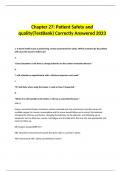Exam (elaborations)
Chapter 27: Patient Safety and quality(TestBank) Correctly Answered 2024
- Course
- Institution
Chapter 27: Patient Safety and quality(TestBank) Correctly Answered 2024 1. A home health nurse is performing a home assessment for safety. Which comment by the patient will cause the nurse to follow up? a. "Every December is the time to change batteries on the carbon monoxide detector."...
[Show more]



